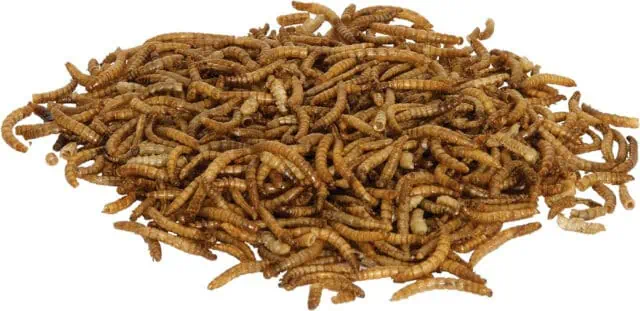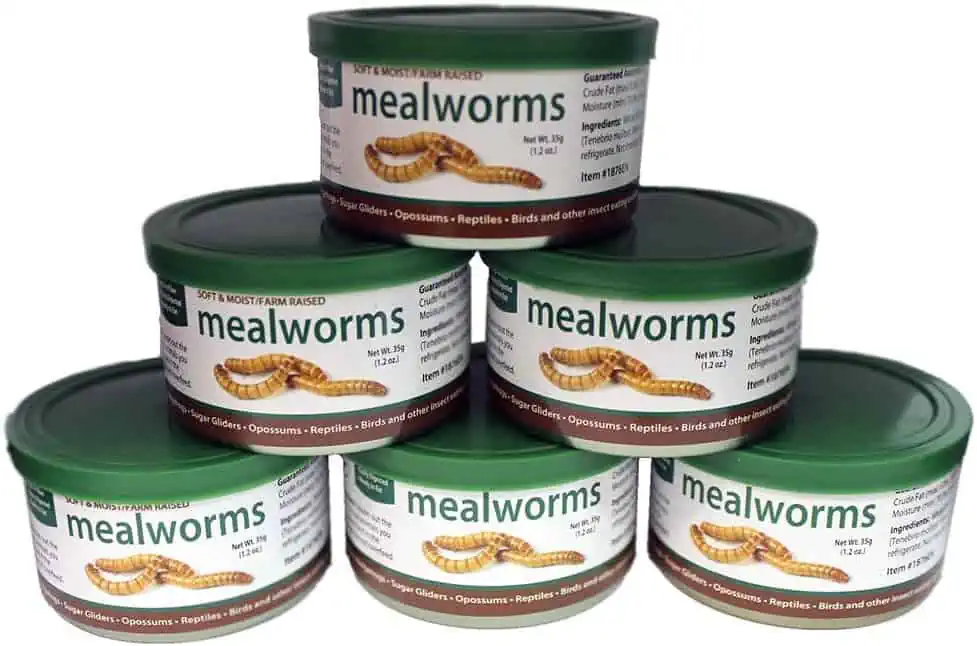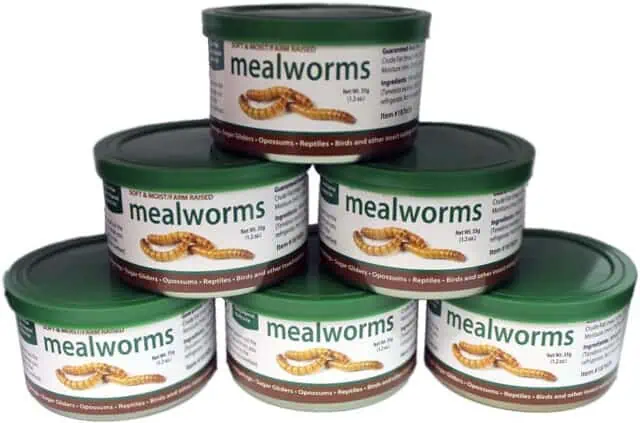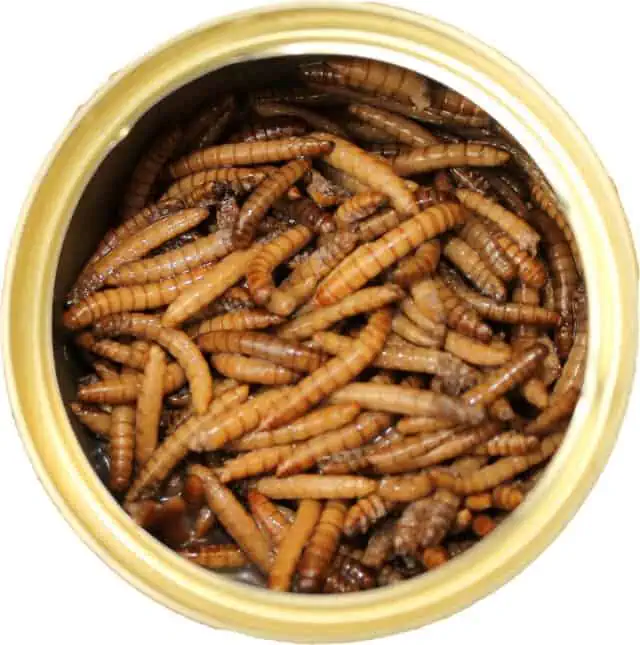Yes, leopard geckos can eat canned mealworms. These specially preserved mealworms serve as a suitable, convenient food source for your pet gecko, providing essential nutrients that contribute to their overall health. While canned mealworms aren’t a substitute for a gecko’s staple diet, they are beneficial as an occasional treat or backup food source.
Canned vs. Live Mealworms: Canned mealworms have more moisture and are softer than dried ones. However, after opening, they should be stored in the refrigerator and used within 3 to 10 days.
Serving Recommendations: Portion sizes vary by the gecko’s life stage. While baby geckos might require smaller servings, juveniles and adults have distinct dietary needs. Still, prioritize live meals, especially for growing geckos.
Feeding Frequency: Due to their high metabolism, adult leopard geckos need to be fed at specific intervals. Ensure you’re not overfeeding and adjust portions accordingly, whether offering live or canned food.
Diet Variety: Incorporate different insects such as crickets, wax worms, silkworm larvae, and cockroaches into your gecko’s diet. This variety not only provides nutritional benefits but also keeps the gecko interested.
Nutritional Aspects: Canned mealworms are rich in protein, carbohydrates, and fats. Additionally, they offer a range of essential vitamins and minerals vital for a gecko’s health. Ensure a balanced intake for optimal health.
Can Leopard Geckos Eat Canned Mealworms?
Indeed, leopard geckos can consume canned mealworms, but it’s crucial to consider this as part of a varied diet. In this section, we will explore what canned mealworms are, their benefits to leopard geckos, and the nutritional value they hold.
What Are Canned Mealworms?

Canned mealworms are essentially mealworms that have undergone a cooking and preservation process, sealed within a can to maintain their freshness. They differ significantly from their dried counterparts, possessing a softer texture and higher moisture content, making them a unique offering for your pet leopard gecko.
Compared to dried mealworms, the canned variety requires mindful handling due to their shorter shelf life. Once opened, they need to be refrigerated and are usually good for about 3 to 10 days, necessitating careful portioning to avoid waste. The softer and moisture-rich nature of canned mealworms can be particularly appealing to some leopard geckos, providing a different texture and hydration compared to the usual dried or live options.
| Feature | Description |
|---|---|
| Texture | Softer than dried mealworms |
| Moisture Content | Higher moisture compared to dried mealworms |
| Shelf Life (Opened) | Lasts 3 to 10 days in the refrigerator |
| Preservation Method | Cooked and preserved in a can |
Remember to store them correctly to ensure your gecko gets the best quality, and monitor their acceptance of this alternative food source to make any necessary dietary adjustments.
Benefits of Feeding Canned Mealworms to Leopard Geckos
Feeding canned mealworms to leopard geckos can be incredibly beneficial, serving as a convenient backup food source packed with some nutritional value. They can be particularly useful when live or fresh options are unavailable, ensuring that your pet’s dietary needs are met without hassle. It’s often better than giving them bugs from outside as a treat.
Pros:
Convenience: Canned mealworms are easy to store and serve, making them a handy option for leopard gecko owners.
Occasional Treats: Offering a variety in texture and taste, they can be used as occasional treats to entice your gecko.
Nutritional Value: They retain some of the nutritional value, contributing to the overall well-being of your leopard gecko.
Cons:
Limited Shelf Life: Once opened, canned mealworms have a shorter shelf life, lasting only 3 to 10 days in the refrigerator.
Acceptance: Some leopard geckos may prefer live or dried mealworms over the canned variety.
Nutritional Loss: Although convenient, they might not offer the same level of nutrients as live mealworms.
| Pros | Cons |
|---|---|
| Easy to store and serve | Limited shelf life once opened |
| Good for occasional treats | Some geckos may prefer live or dried options |
| Retains some nutrients | Possible loss in nutritional value |
Encouraging your leopard gecko to try canned mealworms might require some effort, such as presenting the mealworms using visual cues or offering them in small quantities as a part of varied occasional treats.
Preparing and Serving Canned Mealworms
Preparing and serving canned mealworms in the correct manner is pivotal to ensure that your leopard gecko is receiving optimal nutrition and enjoying its meals.
How to Prepare Canned Mealworms
When it comes to preparing canned mealworms, following a meticulous step-by-step process is essential to ensure the freshness and safety of the food for your leopard gecko. Start by carefully opening the can and using a clean spoon or tweezers to remove the desired amount of mealworms. Avoid using your hands to prevent any contamination.
Once you’ve portioned out the mealworms, place them in a shallow dish inside the leopard gecko’s enclosure, allowing easy access for the gecko. Ensure that the dish is clean and free of any residue from previous feedings.
Handling and storing canned mealworms properly is crucial to maintaining their quality. After portioning, immediately refrigerate the open can, securing it with a tight lid to prevent contamination and preserve freshness. Remember, the opened can of mealworms will last approximately 3 to 10 days in the refrigerator.
| Step | Instructions |
|---|---|
| 1. Opening the Can | Use a can opener and open the can carefully. |
| 2. Portioning | Use a clean spoon or tweezers to remove the mealworms. |
| 3. Serving | Place mealworms in a shallow, clean dish in the gecko’s enclosure. |
| 4. Storing | Refrigerate the open can with a tight lid immediately after portioning. |
It’s imperative to keep an eye on the mealworms’ condition during their shelf life, discarding any that show signs of mold or unpleasant odor, ensuring the safety and health of your leopard gecko.
How Much to Serve
Determining the appropriate serving size of canned mealworms is critical when feeding leopard geckos, and it varies depending on their life stages.
For baby geckos, a moderate amount of about 4-5 mealworms per feeding is recommended, considering their smaller size and dietary needs.
Juvenile geckos, being more active and growing, can be served around 6-9 mealworms per feeding.
In contrast, adult geckos, with their slowed growth, generally require around 8-10 mealworms.
| Life Stage | Serving Size |
|---|---|
| Baby Geckos | 4-5 mealworms |
| Juvenile Geckos | 6-9 mealworms |
| Adult Geckos | 8-10 mealworms |
Maintaining moderation is key, especially for growing geckos, as over-reliance on canned mealworms can lead to nutritional imbalances. Live meals, enriched with vital nutrients, are generally recommended for growing geckos to ensure a well-rounded diet that supports their developmental needs.
Additionally, consider the leopard gecko’s individual appetite and adjust portion sizes as needed, making sure not to overfeed and monitor their weight and health regularly.
Frequency of Feeding
Adult leopard geckos, despite their small size, possess high metabolism; hence, determining the right feeding frequency is crucial. Typically, adult leopard geckos do well when fed every other day. This routine provides a balance, allowing sufficient time for digestion and absorption of nutrients while preventing overfeeding.
| Leopard Gecko Age | Feeding Frequency |
|---|---|
| Adult | Every other day |
Offering the right amount of food is fundamental to avoid overfeeding, which can lead to obesity and related health issues. Whether offering live, freeze-dried, or canned food, appropriate portion sizes should be maintained. For adult geckos, around 8-10 mealworms per feeding session are recommended, but this can be adjusted based on individual dietary needs and preferences.
Serving Suggestions for Leopard Geckos
Serving a variety of insects is paramount for leopard geckos to ensure they receive a balanced and nutritious diet. A diversified menu including crickets (canned crickets are also available), mealworms, wax worms, silkworm larvae, and even cockroaches, offers a range of nutritional benefits, catering to the varied needs of leopard geckos. Each insect type brings a unique set of nutrients and benefits to the table, thus contributing to the overall well-being of the gecko.
| Insect Option | Benefits |
|---|---|
| Crickets | High in protein, low in fat |
| Mealworms | Good source of vitamins |
| Wax Worms | High in fat, good for weight gain |
| Silkworm Larvae | Rich in protein, low in fat, high in calcium |
| Cockroaches | High in protein, good source of vitamins |
Incorporating variety in their diet is crucial, as it prevents nutritional deficiencies and promotes optimal health. However, it’s essential to be mindful of the individual needs and preferences of each gecko, observing their reactions to different insects and adjusting their diet accordingly.
Nutritional Value of Canned Mealworms
When it comes to feeding leopard geckos, understanding the nutritional content of their food is crucial. Canned mealworms, being a convenient and nutritious option, need to be analyzed in terms of their macronutrient profile and the essential vitamins and minerals they contain.
Macronutrients: Protein, Carbohydrates, and Fats
When considering canned mealworms as a food source for leopard geckos, it’s vital to delve into the macronutrient content they offer. Macronutrients, specifically proteins, carbohydrates, and fats, play a significant role in maintaining the health and vitality of leopard geckos. Canned mealworms have distinct macronutrient compositions compared to their live and dried counterparts.
Canned mealworms tend to have a balanced mix of proteins, carbohydrates, and fats, essential for the leopard gecko’s growth and energy. Proteins are pivotal for tissue repair and muscle development, fats act as energy reserves, and carbohydrates provide immediate energy.
Compared to live mealworms, canned ones might have slight alterations in their nutritional profile due to the preservation process.
For example, live mealworms might have around 20% protein, 13% fats, and 2% carbohydrates, whereas canned mealworms might exhibit slightly different percentages due to added preservatives or the canning process. Dried mealworms, having undergone dehydration, often have concentrated protein but lack the moisture content found in canned and live ones.
Vitamin and Mineral Content of Canned Mealworms
Canned mealworms, beyond their macronutrient content, are a source of vital vitamins and minerals crucial for the optimal health of leopard geckos. The nutrient profile of canned mealworms includes essential vitamins and minerals that support various physiological functions and contribute to the overall well-being of the geckos.
These nutrients play significant roles in areas such as bone health, metabolic processes, and immune system functionality, making them indispensable components of a gecko’s diet.
Canned mealworms typically contain vitamins like B12, essential for neurological function and the formation of red blood cells, and minerals like calcium, crucial for bone development and maintenance. They also harbor other nutrients like phosphorus and magnesium, each serving distinct roles in maintaining the health and vitality of leopard geckos.
For instance, calcium is paramount for preventing metabolic bone disease, a common ailment in leopard geckos, while phosphorus is essential for energy metabolism. Magnesium, on the other hand, supports muscle and nerve function.







